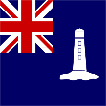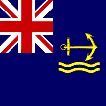Please note, however, there are only two countries who prescribe a distinctive jack for general use by civilian vessels the UK (see pilot jack) and the Bahamas as illustrated below. Sweden, for example, specifies regional flags, whilst the flags of home ports are sometimes officially used and the regulations of some shipping lines call for a house or other flag with this, upon occasion, being expressly permitted under national legislation.
![[Civil Jack]](../images/v/vxt-d183.gif)
![[Civil Jack]](../images/v/vxt-d183a.gif)
From left:
Civil Jack of the Bahamas (fotw); The Netherlands - unofficial (CS)
![[UK Government jack]](../images/v/vxt-d185.gif)


Jacks of The Royal Fleet Auxiliary, The Royal Maritime Auxiliary and Northern
Lighthouse Board, UK (Martin Grieve)
Please note that in UK usage all Government service vessels wearing defaced blue ensigns are egally entitled to fly a blue jack with an appropriate badge in the fly, however, (as far as can be discovered) only the Royal Fleet Auxiliary, the Royal Maritime Auxiliary and the Northern Lighthouse Board actually do so at present.
Please note also that in Germany and Austria, Government (as well as civilian) vessels often fly the flag of the relevant state/province, and that in some commonwealth countries the appropriate departmental flag is specified as a jack for government vessels.
![[Russian naval jack]](../images/v/vxt-d187.gif)
![[Brasil naval jack]](../images/v/vxt-d187a.gif)
![[Norway naval jack]](../images/v/vxt-d187b.gif)
![[Italy naval jack]](../images/v/vxt-d187c.gif)
From left: Naval Jacks of Russia (fotw); Brasil (fotw); Norway (fotw); Italy (fotw)
Please note that this term appears to have been a 19th Century invention, and that there is no firm evidence of it being used during flags lifetime (1606 1801).
![[pirate flags - Jolly Roger]](../images/v/vxt-d189.gif)


From left: Flag as described above (fotw); Submarine Service, UK (CS); Flag of Bartholomew Roberts 17th C (fotw)
Please note with regard to 1) that vessels of the US Navy often fly a Jolly Roger at the yardarm during line-crossing ceremonies (as the signal that King Neptune is aboard), and note also that of all known pirates only Blackbeard is thought to have actually used this design Please note, that vessels of the US Navy often fly a Jolly Roger at the yardarm during line-crossing ceremonies (as the signal that King Neptune is aboard), and note also that no pirates are known to have actually flown this design (see also yardarm).
With regard to 2) it should be emphasised that these symbols were (and are) entirely unofficial, and that a several variations are known.

![[Jack of Honour - FNFL Jack]](../images/v/vxt-d188.gif)